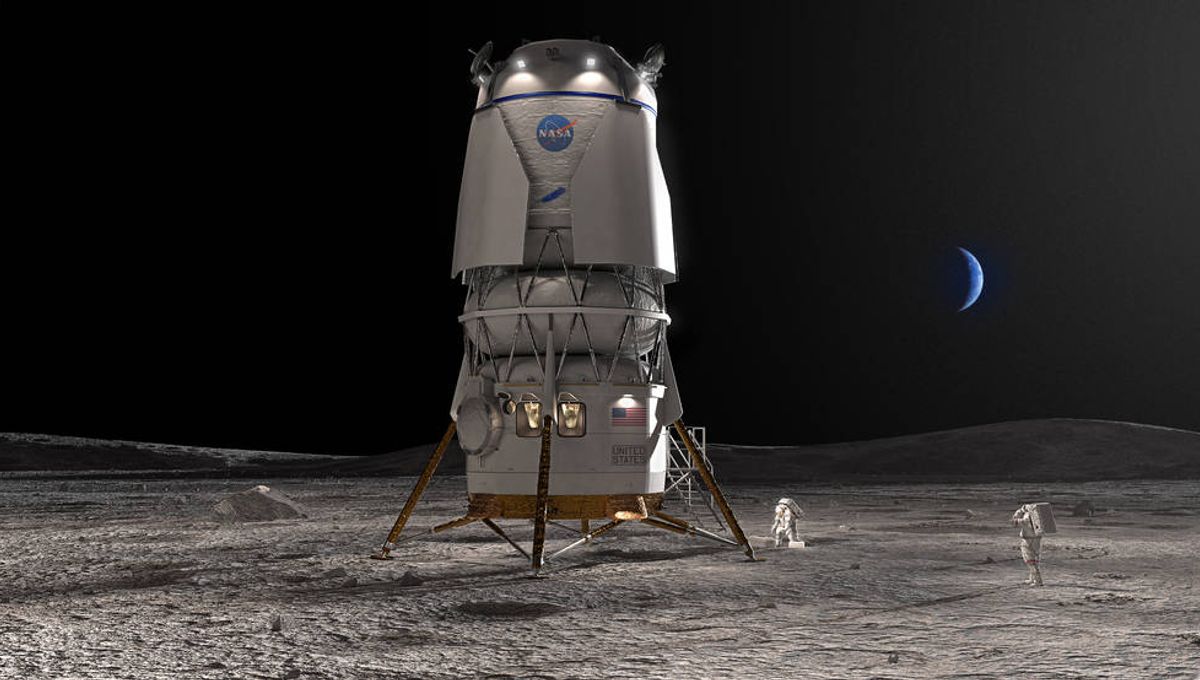
Blue Origin is the second private company to receive a contract to develop a lunar lander for NASA. After SpaceX, it’s Bezos’ company that will be ferrying the Artemis astronauts from Lunar orbit to the surface of the Moon and back. The goal is to have this new landing system ready and tested for Artemis V, currently slated to launch in 2029.
The selection follows a legal battle that took place in 2021, where Blue Origin actually sued NASA for having awarded the contract to the Lunar Lander to SpaceX, losing the appeal. With NASA looking for more commercial partners, Blue Origin put itself forward again and got the job this time. They will build the Blue Moon lander.
With a firm-fixed price contract of $3.4 billion, Blue Origin will have to deliver a human landing system meeting NASA’s requirements for recurring astronaut expeditions that can land on the Lunar surface and can dock with the Gateway, the space station that will be placed in lunar orbit. Before the Artemis V mission, it will have to demonstrate its safety, with an uncrewed landing and lift-off from the surface of the Moon.
“Today we are excited to announce Blue Origin will build a human landing system as NASA’s second provider to deliver Artemis astronauts to the lunar surface,” NASA Administrator Bill Nelson, said in a statement. “We are in a golden age of human spaceflight, which is made possible by NASA’s commercial and international partnerships. Together, we are making an investment in the infrastructure that will pave the way to land the first astronauts on Mars.”
The agency’s current contract with SpaceX is for Artemis III and Artemis IV. It is for a sustainable landing system that can meet the requirements of the agency, including a future larger crew and delivering more materials to the Moon. The test of SpaceX’s Starship last month was a partial success for its rocket, the tallest and most powerful ever launched, which flew but then blew up.
The launchpad was destroyed as it was not ready for such a powerful rocket, with discussion on how it lacked a flame trench or diverter and was also missing a water-deluge system. The damage was extensive and caught on film. According to USFWS, around 385 acres of land were affected by debris from the launch. Musk admitted that the reinforcement of the pad was not ready on time.
It is unclear why the launch was pushed forward – some have speculated that Musk’s “childish obsession” with 420, a number associated with smoking cannabis, is linked to the fact that the launch was planned for April 20. Musk claims that the next test will be in one to two months, but many are skeptical.
This is concerning, as without a successful and safety-tested Starship, Artemis III will have to be postponed. With Blue Origin’s involvement, NASA is no longer putting all its eggs in one basket.
“Having two distinct lunar lander designs, with different approaches to how they meet NASA’s mission needs, provides more robustness and ensures a regular cadence of Moon landings,” said Lisa Watson-Morgan, manager of Human Landing System Program at NASA’s Marshall Space Flight Center in Huntsville, Alabama. “This competitive approach drives innovation, brings down costs, and invests in commercial capabilities to grow the business opportunities that can serve other customers and foster a lunar economy.”
The next lunar launch is Artemis II, which will see the first crew travel around the Moon for the first time in 50 years. The launch is scheduled for November 2024.
Source Link: Blue Origin Vs SpaceX Is Back On: NASA Awards Competitive Lunar Contract To Bezos